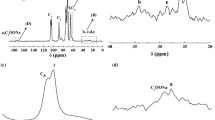Abstract
Flexible nanocellulose composites with silica nanoparticle loading from 5 to 77 wt% and tunable pore size were made and characterised. The pore structure of the new composites can be controlled (100–1000 nm to 10–60 nm) by adjusting the silica nanoparticle content. Composites were prepared by first complexing nanoparticles with a cationic dimethylaminoethyl methacrylate polyacrylamide, followed by retaining this complex in a nanocellulose fibre network. High retention of nanoparticles resulted. The structural changes and pore size distribution of the composites were characterised through scanning electron microscopy (SEM) and mercury porosimetry analysis, respectively. The heavily loaded composites formed packed bed structures of nanoparticles. Film thickness was approximately constant for composites with low loading, indicating that nanoparticles filled gaps created by nanocellulose fibres without altering their structure. Film thickness increased drastically for high loading because of the new packed bed structure. Unexpectedly, within the investigated loading range, the level of the tensile index on nanocellulose mass basis remained constant, showing that the silica nanoparticles did not significantly interfere with the bonding between the cellulose nanofibres. This hierarchically engineered material remains flexible at all loadings, and its unique packing enables use in applications requiring nanocellulose composites with controlled pore structure and high surface area.








Similar content being viewed by others
References
Bringley JF, Wunder A, Howe AM, Wesley RD, Qiao TA, Liebert NB et al (2006) Controlled, simultaneous assembly of polyethylenimine onto nanoparticle silica colloids. Langmuir 22(9):4198–4207
Farhang B (2007) Nanotechnology and lipids. Lipid Technol 19(6):132–135
Garusinghe UM, Raghuwanshi VS, Garvey CJ, Varanasi S, Hutchinson CR, Batchelor W et al (2017) Assembly of nanoparticles–polyelectrolyte complexes in nanofiber cellulose structures. Colloids Surf A 513:373–379
Kausch H, Michler G (2007) Effect of nanoparticle size and size-distribution on mechanical behavior of filled amorphous thermoplastic polymers. J Appl Polym Sci 105(5):2577–2587
Kim J, Yun S, Ounaies Z (2006) Discovery of cellulose as a smart material. Macromolecules 39(12):4202–4206
Kim J-H, Kim J-H, Choi E-S, Yu HK, Kim JH, Wu Q et al (2013) Colloidal silica nanoparticle-assisted structural control of cellulose nanofiber paper separators for lithium-ion batteries. J Power Sour 242:533–540
Klemm D, Schumann D, Kramer F, Heßler N, Hornung M, Schmauder H-P et al (2006) Nanocelluloses as innovative polymers in research and application. Polysaccharides II. Springer, New York, pp 49–96
Korhonen JT, Kettunen M, Ras RH, Ikkala O (2011) Hydrophobic nanocellulose aerogels as floating, sustainable, reusable, and recyclable oil absorbents. ACS Appl Mater Interfaces 3(6):1813–1816
Krol LF, Beneventi D, Alloin F, Chaussy D (2015) Microfibrillated cellulose-SiO2 composite nanopapers produced by spray deposition. J Mater Sci 50(11):4095–4103
Li H, Fu S, Peng L (2013) Surface modification of cellulose fibers by layer-by-layer self-assembly of lignosulfonates and TiO2 nanoparticles: effect on photocatalytic abilities and paper properties. Fibers Polym 14(11):1794–1802
Li Q, Raj P, Husain FA, Varanasi S, Rainey T, Garnier G et al (2016) Engineering cellulose nanofibre suspensions to control filtration resistance and sheet permeability. Cellulose 23(1):391–402
Liu A, Walther A, Ikkala O, Belova L, Berglund LA (2011) Clay nanopaper with tough cellulose nanofiber matrix for fire retardancy and gas barrier functions. Biomacromolecules 12(3):633–641
Lu J, Liong M, Zink JI, Tamanoi F (2007) Mesoporous silica nanoparticles as a delivery system for hydrophobic anticancer drugs. Small 3(8):1341–1346
Ngo YH, Li D, Simon GP, Garnier G (2013) Effect of cationic polyacrylamide dissolution on the adsorption state of gold nanoparticles on paper and their surface enhanced Raman scattering properties. Colloids Surf A 420:46–52
Oksman K, Mathew A, Bondeson D, Kvien I (2006) Manufacturing process of cellulose whiskers/polylactic acid nanocomposites. Compos Sci Technol 66(15):2776–2784
Schaefer DW, Justice RS (2007) How nano are nanocomposites? Macromolecules 40(24):8501–8517
Sehaqui H, Liu A, Zhou Q, Berglund LA (2010) Fast preparation procedure for large, flat cellulose and cellulose/inorganic nanopaper structures. Biomacromolecules 11(9):2195–2198
Sehaqui H, Morimune S, Nishino T, Berglund LA (2012) Stretchable and strong cellulose nanopaper structures based on polymer-coated nanofiber networks: an alternative to nonwoven porous membranes from electrospinning. Biomacromolecules 13(11):3661–3667
Sehaqui H, Zimmermann T, Tingaut P (2014) Hydrophobic cellulose nanopaper through a mild esterification procedure. Cellulose 21(1):367–382
Slowing II, Trewyn BG, Giri S, Lin VY (2007) Mesoporous silica nanoparticles for drug delivery and biosensing applications. Adv Funct Mater 17(8):1225–1236
Tingaut P, Zimmermann T, Lopez-Suevos F (2009) Synthesis and characterization of bionanocomposites with tunable properties from poly (lactic acid) and acetylated microfibrillated cellulose. Biomacromolecules 11(2):454–464
Varanasi S, Chiam HH, Batchelor W (2012) Application and interpretation of zero and short-span testing on nanofibre sheet materials. Nord Pulp Pap Res J 27(2):343
Varanasi S, He R, Batchelor W (2013) Estimation of cellulose nanofibre aspect ratio from measurements of fibre suspension gel point. Cellulose 20(4):1885–1896
Varanasi S, Low Z-X, Batchelor W (2015) Cellulose nanofibre composite membranes—biodegradable and recyclable UF membranes. Chem Eng J 265:138–146
Winey KI, Vaia RA (2007) Polymer nanocomposites. MRS Bull 32(04):314–322
Acknowledgments
We thank MCEM for scanning electron microscopy and Scot Sharman for technical help. The authors acknowledge financial support from the Australian Research Council, Australian Paper, Carter Holt Harvey, Circa, Norske Skog and Visy through Industry Transformation Research Hub Grant IH130100016. U.M.G. thanks Monash University for MGS and FEIPRS scholarships.
Author information
Authors and Affiliations
Corresponding author
Electronic supplementary material
Below is the link to the electronic supplementary material.
Rights and permissions
About this article
Cite this article
Garusinghe, U.M., Varanasi, S., Garnier, G. et al. Strong cellulose nanofibre–nanosilica composites with controllable pore structure. Cellulose 24, 2511–2521 (2017). https://doi.org/10.1007/s10570-017-1265-2
Received:
Accepted:
Published:
Issue Date:
DOI: https://doi.org/10.1007/s10570-017-1265-2




